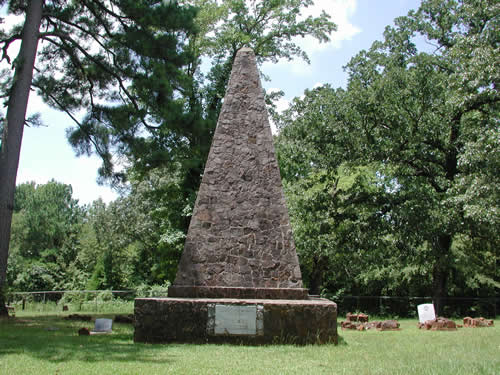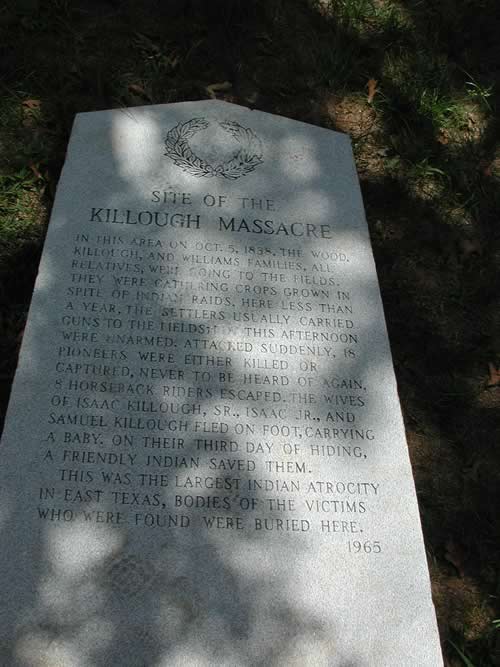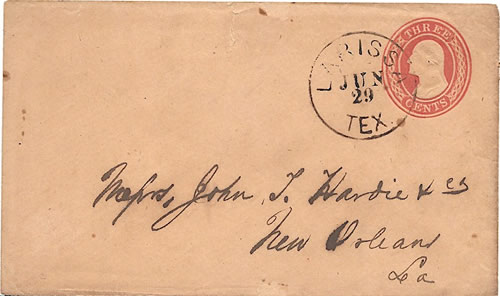Larissa, Texas, Cherokee County ghost town, site of Killough Massacre. (original) (raw)
The native stone monument to the Killough Massacre
CR-3431, Larissa, TX
Photo courtesy Janet Gregg, 2005
History in a Pecan Shell
The area was first settled by Isaac Killough, and his extended family in 1837. After briefly vacating the area for the safety of Nacogdoches, the Killough group returned to harvest their corn crop. The Indians assured the group they would not be molested - but angry because of a broken treaty - the Indians did attack - resulting in what is believed to be the worst Indian attack in Texas history - the Killough Massacre.
Resettlement of the area had to wait until after Texas statehood. In 1846, a group of Tennesseeans arrived under the leadership of a man named Thomas H. McKee. The settlement was known at first as the McKee Colony.
Thomas' son T. N. McKee, platted a townsite naming it after an ancient Greek city famous for education. McKee, who became a Presbyterian minister, insisted on distancing his town from nearby Talladega - since that town had a saloon.
According to legend, in 1848 the Thomas McKee sold a slave in Shreveport and then used the proceeds to buy the town a one-room schoolhouse. In 1855 the school was acquired by the Brazos Synod of the Cumberland Presbyterian Church and became Larissa College. The post office was granted in 1847 and a Masonic lodge opened two years later.
During the early 1850s Talladega started to disappear, its businesses lured to Larissa.
By the mid 1850s, Larissa had a three-story college building, and two large dormitories. In 1866 the Presbyterians stopped supporting the college and it closed its doors in 1870. The town had prospered based on the school's enrollment so when the school closed Larissians started looking for greener pastures.
A meningitis epidemic in 1872 depleted the population further and when things didn't look like they could possibly get worse, the town was bypassed by an arriving railroad (the Kansas and Gulf Short Line Railroad) in 1882. The few remaining families moved to Mount Selman to have a railroad connection.
In the 1880s Black families moved into the abandoned houses and started farming. The post office managed to remain open until 1905 when mail was rerouted through Mount Selman.
During the time the Great Depression arrived, Larissa had a church, a school, a store, and more than a few houses. The residents continued moving for better jobs and by the early 1990s only a few scattered houses and a lodge hall remained at the site.
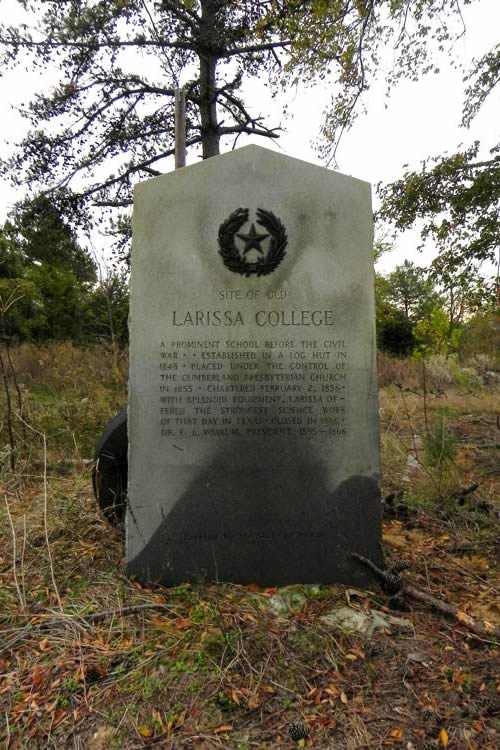
Site of Old Larissa College Centennial Marker
Photo courtesy Barclay Gibson, November 2010
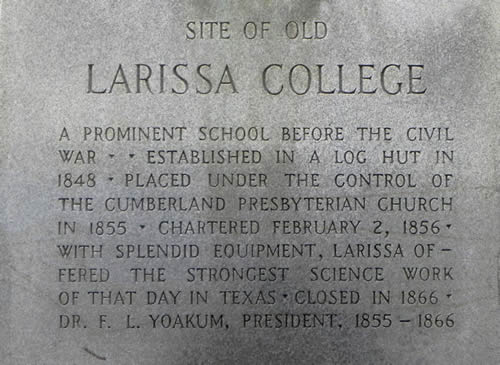
Larissa College Centennial Marker
Photo courtesy Barclay Gibson, November 2010
Texas Centennial Marker:
Site of Old Larissa College
A prominent school before the Civil War.
Established in a log hut in 1848. Placed under the control of the Cumberland Presbyterian Church in 1855. Chartered February 2, 1856. With splendid equipment, Larissa offered the strongest science work of the day in Texas.
Closed in 1866.
Dr. F. L. Yoakum, President, 1855-1866.
1936
Photographer's Note:
Larissa College Centennial Marker location:
"Your GPS is almost the exact location of the marker itself which is just to the northwest under the trees. At the time it was behind an old trailer house."

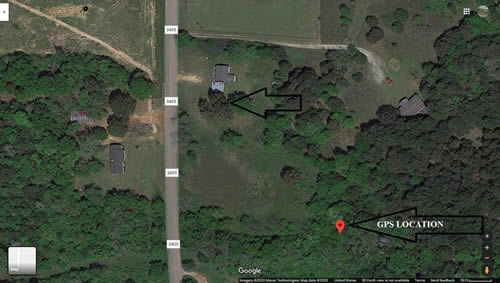
Larissa College Marker Location
Photo courtesy Barclay Gibson, November 2010

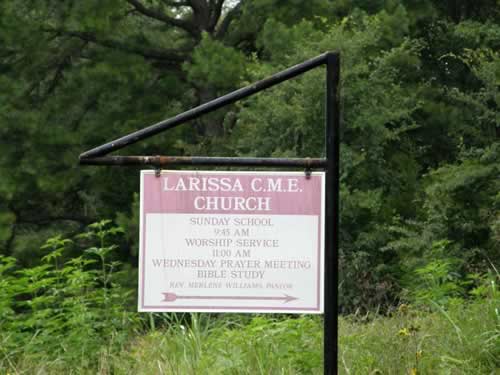
Site of The Killough Massacre historical marker
Photo courtesy Janet Gregg, 2005
The Killough Massacre
The Killough Massacre, October 5, 1838
Story & photos by Janet Gregg
A Monument to the Killough Massacre
by Mitchel Whitington
from "Ghosts of East Texas and the Pineywoods"
"Killough Monument is not the most intuitively obvious place to find, and in fact, I had to make a couple of trips there before I ran across it myself. Here are the directions to make it a little easier on you:
- From the intersection of Highway 69 & Farm/Market (FM) Road 855 go west on FM 855 until you reach FM 3405. There is a sign there (or was at one time) that reads �Killough Monument� and points to the left.
- Turn left on FM 3405 and go just about .4 miles to FM 3411.
- Turn right on FM 3411 and go .6 miles until you reach a road with a green gate with a huge boulder on either side. That is actually FM 3431, but there is no sign there.
- Turn left and proceed through the gate � the monument and cemetery are at the end of the road." [more]

Texas Escapes, in its purpose to preserve historic, endangered and vanishing Texas, asks that anyone wishing to share their local history, stories, landmarks and recent or vintage photos, please contact us.
